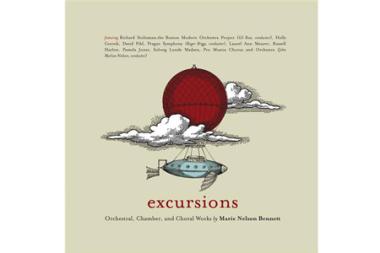Most of the CDs that arrive in the Advocate‘s review stack fall within the bounds of what’s considered “popular” music. Some reside on the edges of that descriptor—”noise” artists, stories set to music, experiments of various sorts—but mostly, it’s a stack of rock, pop, folk, blues, hip-hop, world music and jazz.
Lately, the arrivals for the review stack have grown significantly wider in scope, for reasons unknown. We’ve received more and more emissaries from a less-travelled musical universe, one that’s plenty interesting but is often neglected in the pages of alt-weeklies and dailies alike. I’m talking about the world of “contemporary composers.” Their music is out there, being played by talented ensembles, even entire orchestras, but most of us would be hard pressed to squeeze out of our brains even one or two names of contemporary composers.
It must be a tough path to walk. Contemporary composers rarely get the play of old standby classical composers in the repertoires of major orchestras. Their music can be demanding stuff to listen to, full of jarring disharmony and cranium-rattling brazenness—even fans of orchestral music don’t always cotton to it. There’s a built-in lack of audience. There’s also a built-in difficulty with obtaining recordings of it—most record stores lack a section called “contemporary composers.”
Maybe all of this is the result of the rock ‘n’ roll tyranny that began in the ’50s, when the stuff dubbed “devil music” rolled in like a tsunami to overwhelm radio waves and record collections. That genre and its thousand variants have hardly loosened their grips on our musical culture since. Jazz guys had to pack up the horns and move to the margins; orchestras primarily remained citadels of traditionalist taste. Suddenly the scandalous embracing of dissonance, even the 12-tone assault on traditional orchestral sounds, seemed tame. All of this is, of course, terribly unfair to the well-schooled musicians who even now endeavor to use the traditional musical palette of greats like Beethoven and Bach to craft works that spring from modern concerns.
I therefore approached this new subsection of review CDs with great interest. I often find contemporary compositions great listens, but I don’t necessarily have a list, small or large, of favorites. I chose to judge the books by their covers to find a starting point.
The first contender was excursions, orchestral, chamber and choral works by Marie Nelson Bennett. The disc bears an illustration of a flying machine that looks like a submarine tethered to a balloon. (I’m a sucker for steampunk.) The music within was, in a word, gorgeous. Bennett seems to love some less-employed instruments in the classical repertoire, things like English horn and clarinet. Her work seldom heads for the brassy or blaring, moving along pleasant melodic pathways where, for lack of a better term, “modernness” resides in the margins, underlining melodies with chord structures that might turn dark and stormy or hypnotically dissonant at any moment. It’s perhaps telling that much of her music sounds like a perfect accompaniment to a dreamy, surreal film; it’s certainly there that contemporary composers most often find their ways to large numbers of listeners.
Bennett’s music falls between the extremes of always-pleasant, more traditional harmonic structures and the clanging anxieties of composers who want to liberate listeners from the strictures of the merely pleasant. Her range of colors is wide, and she seldom resides for long in places of easy expectation. Sounds evoking a sun-dappled glade might well turn wild, then return to being contemplative. It’s a fascinating ride.
This disc is accompanied by Bennett’s own liner notes, themselves a rewarding study that reveals a stout personality. Bennett possesses a string of letters after her name, and, with the aid of whatever alternate channels of musical success propel contemporary composers, she’s written works debuted by the likes of the London Symphony and the Boston Modern Orchestra. Her liner notes possess a heavy dose of flamboyant braggadocio and a boatload of helpful guides to her compositions. They make it easy to access her musical world, demanding passages or no.
It’s well worth your while to pick up excursions (available through Ravello Records) to open the door to what is almost an alternate musical universe, well away from the crowded byways of pop. It probably won’t all prove pleasing, but it’s a true musical adventure in terra (mostly) incognita, and that’s a hard thing to come by anymore.



